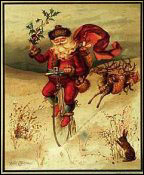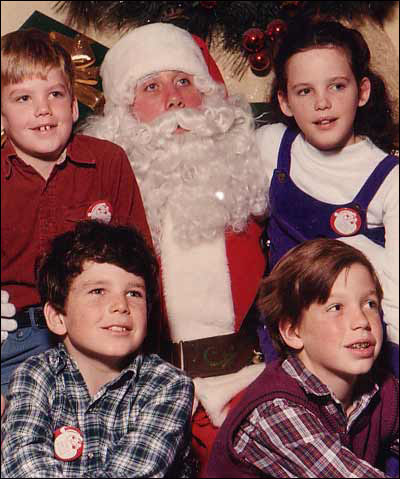Part 1 圣诞节的来历
Part 2 The History of Santa Claus 圣诞老人的来历
Part 3 The Christmas Tree 圣诞树
Part 4 Christmas Stockings and Christmas Cards 圣诞袜和圣诞卡
Part 5 Christmas Party 庆祝圣诞节
Part 2 The History of Santa Claus 圣诞老人的来历
On the night before Christmas, all across the world, millions of children will be tucked in their beds while "visions of sugarplums dance in their heads." When they awake they will check their stockings to see if Santa Claus has come.
Santa Claus has become the most beloved of Christmas symbols and traditions. The image of the jolly old elf flying in a sleigh pulled by reindeers and leaving toys and gifts for every child is know worldwide.
Just like the season of Christmas, the history of the origins of Santa Claus is influenced by the customs and cultures of many countries, beginning in Asia Minor sometime around the 4th century AD. It was here that Bishop Nicholas became renowned for his exceptional generosity, especially to the very you ng. Many years later he became known as Saint Nicholas, the patron saint of children.
ng. Many years later he became known as Saint Nicholas, the patron saint of children.
As time went on, adults began to dress in the manner of Saint Nicholas, dressed in Bishops vestments and carrying a staff., to re-enact the kindness of the saint. They went from house to house, asking if the children who lived there had been well behaved. In response to these visits, the children left their shoes outside the doors of their houses so that next morning they might find them filled with sweets and trinkets.
An Anglo-Saxon version eventually evolved and was known as Father Christmas. His character was a mixture of the Saint Nicholas and earthly perceptions of the gods Thor and Saturn. He wore robes decorated with ivy and holly and carried a switch to threaten unruly children, as well as a bag of toys to reward the well behaved.
In North America the British, German and Dutch settlers introduced their own derivations of Father Christmas and of these the Dutch figure of 'Sinterklaas' became the common favourite. Eventually this name was anglicised to become Santa Claus, the mythical figure of Christmas who placed toys, sweets and trinkets into stockings hung by the fireplace.
The modern perception of the character of Father Christmas was greatly influenced by Thomas Nast, a cartoonist with Harpers Weekly, who published a drawing of Santa Claus in 1860. This was a portly figure with white hair and a long beard, dressed in a red robe and wearing a crown of holly, holding a long clay pip e similar to that of Sinterklaas.
e similar to that of Sinterklaas.
Perhaps the final stage in the evolution of the modern Santa Claus was brought about by publicity from the Coca Cola Company. They launched an advertising campaign in the 1930s with Santa Claus as the central figure and subsequently used the motif for the next forty years or so.
This conception of Santa Claus was produced for them by Haddon Sundblom, who built on the character and costume created by Thomas Nast to produce a cheery, chubby fellow that is still a familiar perception of the mythical Christmas character to millions of people throughout the Western world.
圣诞老人的传说在数 千年前的斯堪的纳维亚半岛即出现。北欧神话中司智慧,艺术,诗词,战争的奥丁神,寒冬时节,骑上他那八脚马坐骑驰骋于天涯海角,惩恶扬善,分发礼物。与此同时,其子雷神着红衣以闪电为武器与冰雪诸神昏天黑地恶战一场,最终战胜寒冷。据异教传说,圣诞老人为奥丁神后裔。也有传说称圣诞老人由圣·尼古拉而来,所以圣诞老人也称St.Nicholas.因这些故事大多弘扬基督精神,其出处,故事情节大多被淡忘,然而圣诞老人却永驻人们精神世界。
千年前的斯堪的纳维亚半岛即出现。北欧神话中司智慧,艺术,诗词,战争的奥丁神,寒冬时节,骑上他那八脚马坐骑驰骋于天涯海角,惩恶扬善,分发礼物。与此同时,其子雷神着红衣以闪电为武器与冰雪诸神昏天黑地恶战一场,最终战胜寒冷。据异教传说,圣诞老人为奥丁神后裔。也有传说称圣诞老人由圣·尼古拉而来,所以圣诞老人也称St.Nicholas.因这些故事大多弘扬基督精神,其出处,故事情节大多被淡忘,然而圣诞老人却永驻人们精神世界。
在德国,传说他把坚果和苹果放在孩子们鞋里。他乘双轮马车四处漫游,观察人们的行为,尤其是小孩,如果表现好,将会得到苹果、坚果、糖等诸多奖品。坏孩子则得一鞭子。家长们灵机一动纷纷采用此传说来鼓励孩子们听话。大大超过了新年,成为一个全民的节日。圣诞老人已经成为圣诞节最受喜爱的象征和传统。他赶着驯鹿,拉着装满玩具和礼物的雪橇挨家挨户给每个孩子送礼物的快乐老精灵的形象已深深地留在人们的记忆中。
19世纪60年代卡通制作者Thomas Nash画了一幅胖胖的、慈祥的圣诞老人作为《Harper的一周》的插图。这个圣诞老人的形象开始深深地扎根于美国人民的脑海中。随着时间的推移,圣诞老人的形象传回欧洲,传到南美洲,传遍世界各地。
